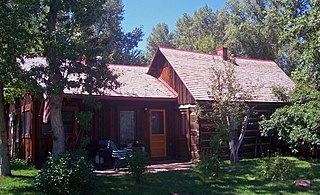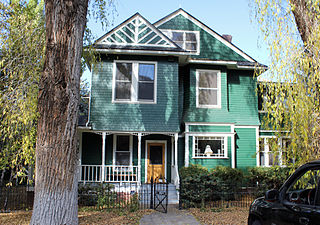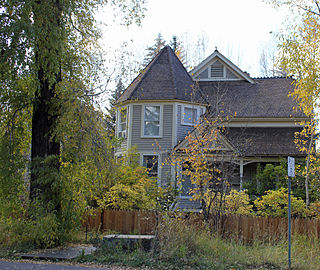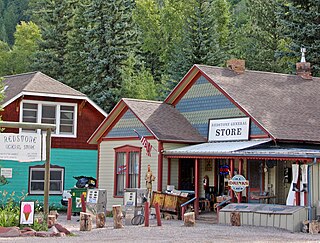
Davis Hanson Waite was an American politician. He was a member of the Populist Party, and he served as the eighth Governor of Colorado from 1893 to 1895.

This is a list of the National Register of Historic Places listings in Pitkin County, Colorado.

The Thomas D. Campbell House is a historic Gothic Revival style log and wood frame home located in Grand Forks, North Dakota. It is significant for its association with Thomas D. Campbell, who became the largest wheat farmer in the United States. It is part of the Myra Museum and is listed on the National Register of Historic Places.

The Terwilliger–Smith Farm is located on Cherrytown Road near the hamlet of Kerhonkson in the Town of Rochester in Ulster County, New York, United States. It was established in the mid-19th century.

The La Fave Block is located at the intersection of East Cooper Avenue and South Hunter Street in Aspen, Colorado, United States. It is a brick commercial building erected in the late 1880s, during the initial mining boom that created Aspen. Today it is the second oldest brick commercial building in the city, and, along with its neighbors on East Cooper, the only structure left built by Frank LaFave, one of Aspen's early settlers. It was listed on the National Register of Historic Places in 1987.

The Red Onion is a restaurant located on East Cooper Avenue in Aspen, Colorado, United States. It is the oldest restaurant in the city, housed in a three-story red brick Italianate building dating to the late 19th century. In 1987 it was listed on the National Register of Historic Places as "New Brick–The Brick Saloon", along with other historic properties in the city.

The Dixon–Markle House is located at the corner of East Cooper Avenue and South Aspen Street in Aspen, Colorado, United States. It is a wood frame house erected in the 1880s. In 1987 it was listed on the National Register of Historic Places along with other properties in the city.

The former Riede's City Bakery building is located on East Hyman Street in Aspen, Colorado, United States. It is a small wooden commercial building erected in the 1880s. In 1987, it was listed on the National Register of Historic Places.

Pioneer Park, also known as the Henry Webber House or the Webber–Paepcke House, is located on West Bleeker Street in Aspen, Colorado, United States. It is a brick structure erected in the 1880s, one of the few such homes in the city. In 1987 it was listed on the National Register of Historic Places.

The Samuel I. Hallett House is located on West Francis Avenue in Aspen, Colorado, United States. It is a timber frame structure built in the late 19th century. In 1987 it was listed on the National Register of Historic Places.

The Bowles–Cooley House is located at the corner of West Francis and North First streets in Aspen, Colorado, United States. It is a brick structure in the Queen Anne architectural style built during the 1880s. In 1987 it was listed on the National Register of Historic Places along with many other historic properties in the city.

The Matthew Callahan Log Cabin is located on South Third Street in Aspen, Colorado, United States. It was built in the early 1880s. In 1987 it was listed on the National Register of Historic Places along with a group of other historic properties in the city.

The Thomas Hynes House on East Main Street in Aspen, Colorado, United States, is a wooden building from the 1880s. In 1987 it was listed on the National Register of Historic Places as part of a group of historic properties in the city.

The Lake of the Woods Ranger Station is a United States Forest Service compound consisting of eight buildings overlooking Lake of the Woods in the Fremont-Winema National Forests of southern Oregon. All of the ranger station structures were built by the Civilian Conservation Corps between 1937 and 1939. Today, the compound serves as a Forest Service work center, and the old ranger station office is a visitor center. The ranger station is listed on the National Register of Historic Places.

The D.E. Frantz House is located on West Bleeker Street in Aspen, Colorado, United States. It is a wooden frame house constructed for a local lumber magnate during the 1880s in the Queen Anne architectural style. It has remained a private residence ever since and is largely intact. In 1987 it was listed on the National Register of Historic Places along with other historic properties in the city. Included in the listing is a small barn in the back, although the date of its construction is not known.

The Newberry House, also known as the Judge Shaw House, is located on Lake Avenue in Aspen, Colorado, United States. It is a wooden structure in the Shingle Style built around 1890. In 1987 it was listed on the National Register of Historic Places along with other properties in the city.

The Shilling–Lamb House, also sometimes referred to as Victoria House, is located on North Second Street in Aspen, Colorado, United States. It is a wood frame structure in the Queen Anne architectural style built around 1890. In 1987 it was listed on the National Register of Historic Places.

The Smith–Elisha House, sometimes known just as the Elisha House or the Christmas Tree House, is located on West Main Street in Aspen, Colorado, United States. It is a wood frame structure in the Queen Anne style built in the late 19th century. In 1989 it was listed on the National Register of Historic Places.

The Redstone Historic District is located in and near the unincorporated community of that name in western Pitkin County, Colorado, United States. It includes the original community of Redstone as built by Colorado Fuel and Iron (CFI) for the coal miners it employed. In 1989 it was recognized as a historic district and listed on the National Register of Historic Places.

The Osgood–Kuhnhausen House, also known as Carina's Cottage, is located on Redstone Boulevard in Redstone, Colorado, United States. It is a timber frame structure built at the beginning of the 20th century in the Tudor Revival architectural style. In 1983 it was listed on the National Register of Historic Places.






















